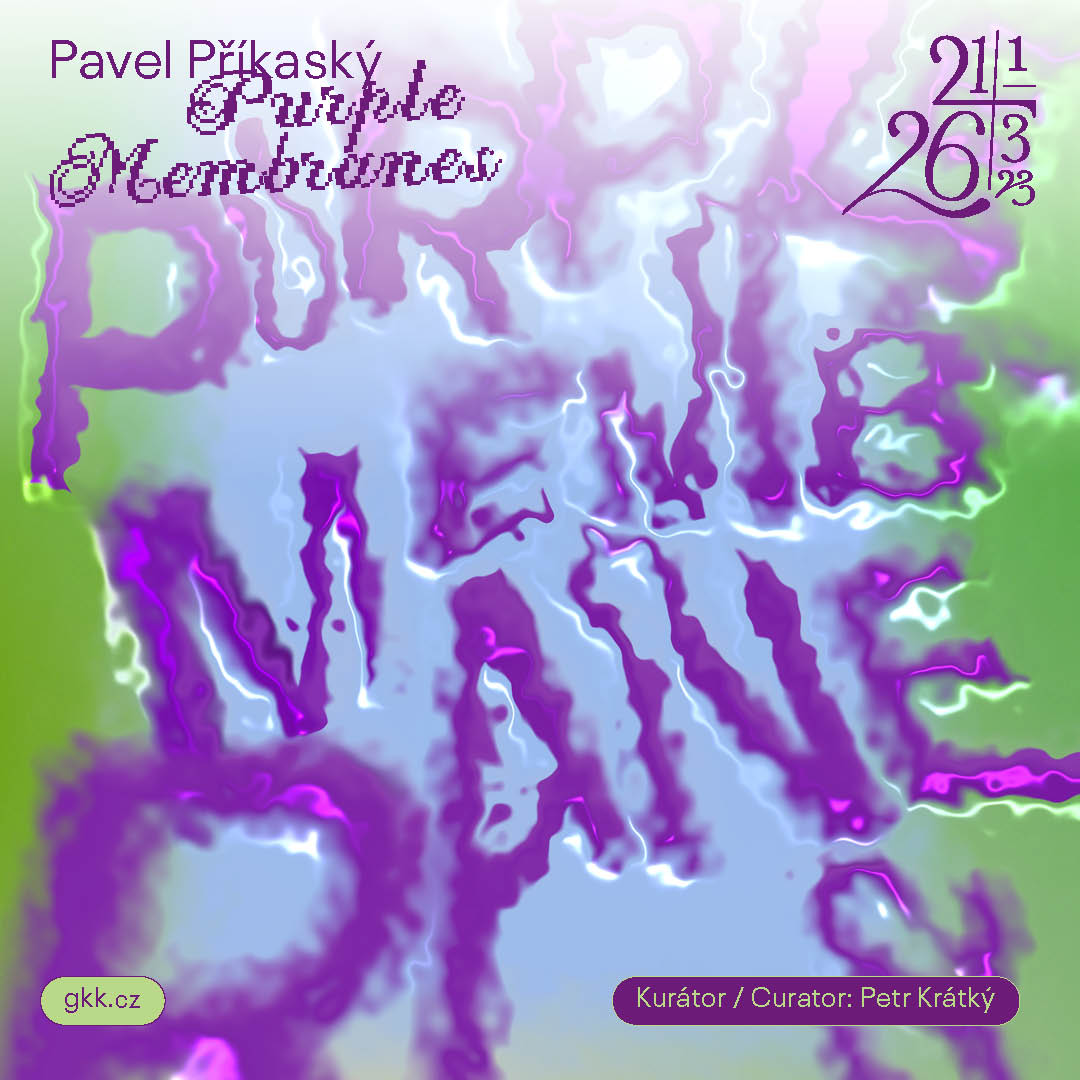Pavel Příkaský / Purple Membranes

White Unicorn Gallery in Klatovy
21. 1. - 26. 3. 2023
WEST POINT – SOLO
Pavel Příkaský – Purple Membranes
Curator: Petr Krátký
Graphic design: Matěj Moravec
Exhibition installation: Petr Kotěšovec, Karel Ludvík, Jiří Machulda, Ladislav Sýkora
White Unicorn Gallery in Klatovy
21. 1. – 26. 3. 2023
West Point, a repeating exhibition project with a focus on artists whose work has been shaped by western Bohemia, continues at the Klatovy/Klenová Gallery. Following the first edition of this survey of painters from the younger middle generation in 2021 at Pilsen City Gallery and the event’s continuation at Klatovy’s White Unicorn Gallery in 2022, that same year in Pilsen the West Point project organized Solo, an exhibition by the painter Tomáš Predka. In line with the concept behind West Point, a collective showing is followed by a presentation by one of the exhibition’s distinctive artists. This year’s solo showing in Klatovy has been put together by the artist Pavel Příkaský; the next group exhibition in this series is scheduled for April in Pilsen, curated by Radek Wohlmuth.
Pavel Příkaský (1985, Planá near Mariánské Lázně)
Příkaský attended the Zámeček Secondary School of Applied Arts in Pilsen, did a study exchange at Middlesex University in London, and then studied printmaking under Vladimír Kokolia at the Academy of Fine Arts in Prague, from where he graduated in 2012. His works can be found in collections in the Czech Republic and abroad. He lives and works in Prague.
One long-standing subject has been environmental themes, which Příkaský has long processed and explored using mythological stories. The mixed visual nature of his latest works, in which he has been moving from figurative depiction towards pure abstraction, is ever more frequently expressed in his approach to painting, with an increased emphasis on the physical substance of the paint, on structure, and on perforation. Not rarely does he use other materials such as fringes, pastes, or gels that expand beyond the frame of the painting and out into space. If we additionally consider the artist’s growing interest in an almost anthropological exploration of the human body and on this basis try to interpret the exhibition title’s scientific formulation, we get a fairly clear idea of what it is about.
“The purple membrane directs light energy. It is part of a cell’s cytoplasmic membrane, the thin layer that separates a living cell’s interior from its surroundings and controls the movement of substances in and out of the cell, essentially protecting it from outside influences. The membrane gives cells their shape and influences their attachment to other cells. Basically, it helps groups of cells to form together into more complex tissues.”
The work of Pavel Příkaský is characterized by a certain duality. Although he is mainly a painter, he often expresses himself through striking installations, and this exhibition is no exception. Some of the exhibited paintings are woven into the passageways of the rooms, whose wood paneling thus forms a profiled picture frame. In this way, the exhibition’s architectural design plays with established perceptions of the gallery space and guides the viewer’s movement through this space. The lower edges of not just these particular paintings are deliberately in line with the floor and, along with the paintings’ almost biologically elaborated surfaces, create a visual illusion of portals through which we can get a closer look at the imaginative environment being presented to us. These inner worlds filled with a distinct flora and fauna are the site of blending of what at first glance appear to be outdated physiognomic and cultural characteristics.
The atavistic approach to the exhibited themes not rarely reflects and explores contemporary global issues, sensitively interpreted by the artist via the aesthetics of fantasy as a genre that allows him, objectively and with a certain degree of detachment, to offer alternative solutions to often catastrophic predictions that, to our astonishment, are increasingly becoming real.
Humanity, in its unsustainable desire for endless material growth, is a fundamental threat to itself and to the delicate balance of life on earth. Only a fine line separates us from this fate becoming reality in the form of a dystopian labyrinth of contemporary crises from which there may be no escape.
We have the opportunity to briefly stop and try to look back, to find, in the tangle of organic structures, a point of reference for effecting renewal and discovering the true cause of this dysfunction instead of just treating its superficial symptoms.
Careful work with the image and an economical yet consistent approach offer the tools for how to most effectively grasp and subsequently absorb a complex artistic position. The eclectic whole confirms our ambiguous conviction regarding man’s superiority over other living things.
Fragments of our collective memory become flesh.
An organic flowering spreads throughout the space in order to eventually encompass the last remnants of pictorial reality and create an entropic image of primal life-giving matter.
It is a cycle of beginnings and endings in which melancholic nostalgia is followed by new expectations.
Descriptive representation alternates with abstraction.
The entire installation resonates with a certain rhythm.
Like membranes, the images are a dividing line, but they also open themselves up to an interchange with the viewers and with one another.
They support each other with one shared goal in mind:
To form a complex yet compact structure that can act as a safe foundation for the artist’s imagination and thus help to understand the presented themes and works, meaning the exhibition as a whole.


 Česky
Česky
